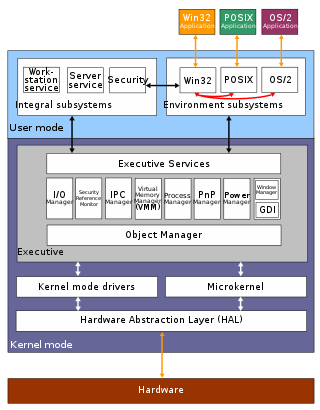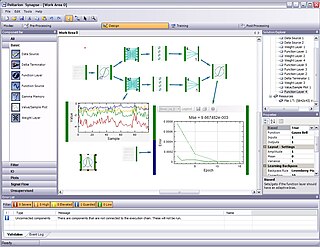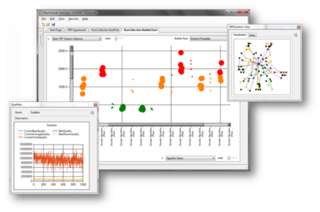Visual Basic for Applications (VBA) is an implementation of Microsoft's event-driven programming language Visual Basic 6.0 built into most desktop Microsoft Office applications. Although based on pre-.NET Visual Basic, which is no longer supported or updated by Microsoft, the VBA implementation in Office continues to be updated to support new Office features. VBA is used for professional and end-user development due to its perceived ease-of-use, Office's vast installed userbase, and extensive legacy in business.
In computing, DLL Hell is a term for the complications that arise when one works with dynamic-link libraries (DLLs) used with Microsoft Windows operating systems, particularly legacy 16-bit editions, which all run in a single memory space.

The Windows API, informally WinAPI, is the foundational application programming interface (API) that allows a computer program to access the features of the Microsoft Windows operating system in which the program is running.
In computing, the Windows Sockets API (WSA), later shortened to Winsock, is an application programming interface (API) that defines how Windows network application software should access network services, especially TCP/IP. It defines a standard interface between a Windows TCP/IP client application and the underlying TCP/IP protocol stack. The nomenclature is based on the Berkeley sockets API used in BSD for communications between programs.
In computing, Dynamic Data Exchange (DDE) is a technology for interprocess communication used in early versions of Microsoft Windows and OS/2. DDE allows programs to manipulate objects provided by other programs, and respond to user actions affecting those objects. DDE was partially superseded by Object Linking and Embedding (OLE), and is currently maintained in Windows systems only for the sake of backward compatibility.

Hardware acceleration is the use of computer hardware designed to perform specific functions more efficiently when compared to software running on a general-purpose central processing unit (CPU). Any transformation of data that can be calculated in software running on a generic CPU can also be calculated in custom-made hardware, or in some mix of both.
A systems integrator is a person or company that specializes in bringing together component subsystems into a whole and ensuring that those subsystems function together, a practice known as system integration. They also solve problems of automation. Systems integrators may work in many fields but the term is generally used in the information technology (IT) field such as computer networking, the defense industry, the mass media, enterprise application integration, business process management or manual computer programming. Data quality issues are an important part of the work of systems integrators.
A dynamic-link library (DLL) is a shared library in the Microsoft Windows or OS/2 operating system.
The Predictive Model Markup Language (PMML) is an XML-based predictive model interchange format conceived by Robert Lee Grossman, then the director of the National Center for Data Mining at the University of Illinois at Chicago. PMML provides a way for analytic applications to describe and exchange predictive models produced by data mining and machine learning algorithms. It supports common models such as logistic regression and other feedforward neural networks. Version 0.9 was published in 1998. Subsequent versions have been developed by the Data Mining Group.
Microsoft SQL Server Integration Services (SSIS) is a component of the Microsoft SQL Server database software that can be used to perform a broad range of data migration tasks.
Neural network software is used to simulate, research, develop, and apply artificial neural networks, software concepts adapted from biological neural networks, and in some cases, a wider array of adaptive systems such as artificial intelligence and machine learning.

Synapse is a component-based development environment for neural networks and adaptive systems. Created by Peltarion, Synapse allows data mining, statistical analysis, visualization, preprocessing, design and training of neural networks and adaptive systems and the deployment of them. It utilizes a plug-in based architecture making it a general platform for signal processing. The first version of the product was released in May 2006.
The Microsoft Windows operating system supports a form of shared libraries known as "dynamic-link libraries", which are code libraries that can be used by multiple processes while only one copy is loaded into memory. This article provides an overview of the core libraries that are included with every modern Windows installation, on top of which most Windows applications are built.
RATS, an abbreviation of Regression Analysis of Time Series, is a statistical package for time series analysis and econometrics. RATS is developed and sold by Estima, Inc., located in Evanston, IL.
The Advanced Learning and Research Institute (ALaRI), a faculty of informatics, was established in 1999 at the University of Lugano to promote research and education in embedded systems. The Faculty of Informatics within very few years has become one of the Switzerland major destinations for teaching and research, ranking third after the two Federal Institutes of Technology, Zurich and Lausanne.
Component Object Model (COM) is a binary-interface technology for software components from Microsoft that enables using objects in a language-neutral way between different programming languages, programming contexts, processes and machines.

HeuristicLab is a software environment for heuristic and evolutionary algorithms, developed by members of the Heuristic and Evolutionary Algorithm Laboratory (HEAL) at the University of Applied Sciences Upper Austria, in Hagenberg im Mühlkreis. HeuristicLab has a strong focus on providing a graphical user interface so that users are not required to have comprehensive programming skills to adjust and extend the algorithms for a particular problem. In HeuristicLab algorithms are represented as operator graphs and changing or rearranging operators can be done by drag-and-drop without actually writing code. The software thereby tries to shift algorithm development capability from the software engineer to the user and practitioner. Developers can still extend the functionality on code level and can use HeuristicLab's plug-in mechanism that allows them to integrate custom algorithms, solution representations or optimization problems.
Crowdsourcing software development or software crowdsourcing is an emerging area of software engineering. It is an open call for participation in any task of software development, including documentation, design, coding and testing. These tasks are normally conducted by either members of a software enterprise or people contracted by the enterprise. But in software crowdsourcing, all the tasks can be assigned to or are addressed by members of the general public. Individuals and teams may also participate in crowdsourcing contests.
ASP.NET Web Forms is a web application framework and one of several programming models supported by the Microsoft ASP.NET technology. Web Forms applications can be written in any programming language which supports the Common Language Runtime, such as C# or Visual Basic. The main building blocks of Web Forms pages are server controls, which are reusable components responsible for rendering HTML markup and responding to events. A technique called view state is used to persist the state of server controls between normally stateless HTTP requests.

Owl Scientific Computing is a software system for scientific and engineering computing developed in the Department of Computer Science and Technology, University of Cambridge. The System Research Group (SRG) in the department recognises Owl as one of the representative systems developed in SRG in the 2010s. The source code is licensed under the MIT License and can be accessed from the GitHub repository.





